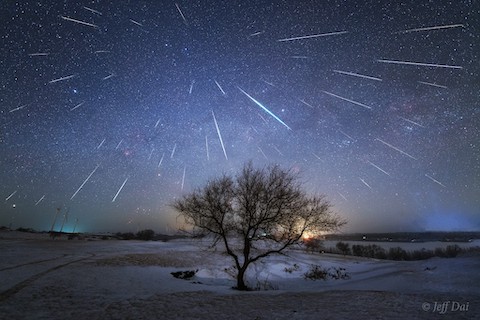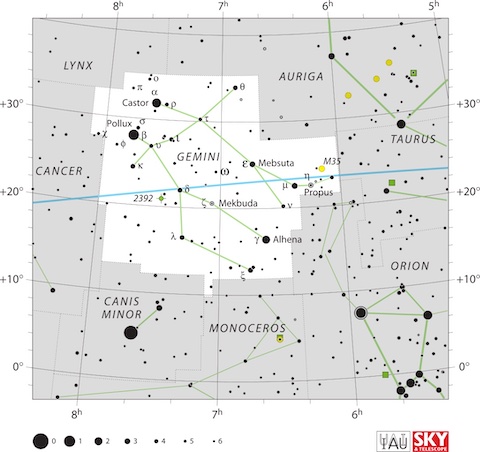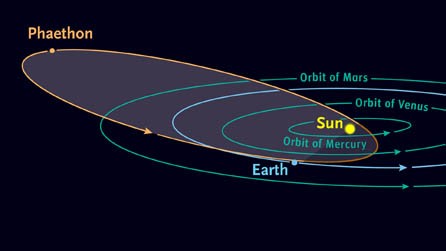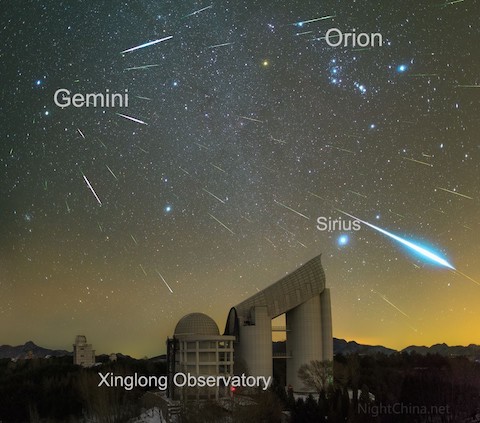
Credit: Jeff Dai and The World at Night, via NASA Astronomy Picture of the Day
You may have seen meteor showers and wondered what they are. Well, most are actually the icy tails of comets.
As comets travel, they shed particles of dust and ice, then pull them behind in their wake to form a long tail. Each year, Earth’s orbital path passes through the tails of several comets that also orbit within our solar system.
When that happens, the particles burn up in our atmosphere. We see them as shooting stars.
There’s a particularly bright meteor shower that appears in the sky each December near the constellation Gemini—and is therefore called the Geminids.
These aren’t a comet tail, but instead the dust plume from a four-mile-wide rocky asteroid called 3200 Phaethon.
It also orbits the sun, at times traveling near enough that its surface gets superheated, causing it to spit off mineral dust, which it then pulls behind it like a comet tail.
You can see the Geminid meteor shower from around December 7 through 14, with the last two nights being the most spectacular.
For best viewing, you’ll need to be up around two in the morning. Find a place away from the city lights. Then find Gemini in the sky. Allow your eyes to adjust to the darkness, then get ready for the show.
Geminid meteor showers can produce hundreds of shooting stars, some multicolored. If you’ve got a friend with you, let them know they’re actually looking at asteroid dust—and that they can find out more at EarthDate.org.
Background
Synopsis: Each year, in mid-December, Earth passes through the dusty debris left behind by an asteroid, treating us to a light show known as the Geminids meteor shower. The meteors get their name from the constellation Gemini, because the streaks of light appear to radiate from it. Unlike most meteor showers, which come from debris left by icy comets, the sand-sized Geminids particles are the product of a rocky asteroid called 3200 Phaethon that orbits our sun in a skewed elliptical path every 1.43 Earth years.
- Meteor showers are predictable, occurring at the same time each year as Earth’s orbit traverses trails of dust left behind by small celestial bodies in our solar system.
- Meteor showers have been documented since 36 CE and can be seen from most of Earth’s surface.
- In 1866, Giovanni Schiaparelli linked August’s annual display of the Perseids meteors to the Swift-Tuttle comet. Since that realization, most other annual meteor displays have been matched with other comets (see a list here).
- Comets consist of dust and volatile ices that sublimate (change directly from solid to gas) when they approach the sun, forming a bright tail known as a coma.
- As the comet passes, it leaves a trail that includes tiny, mostly sand sized grains called meteoroids.
- If Earth’s orbit crosses one of these trails, the particles flare brightly as they disintegrate in Earth’s atmosphere, creating the effect that we call a meteor shower.
- Meteor showers appear to radiate from the same place in the sky at the same time every year, as Earth passes through the same coma trail during each of its annual transits around the sun.

Credit: International Astronomical Union and Sky & Telescope magazine (Roger Sinnott & Rick Fienberg), via Wikimedia Commons
- The Geminids occur reliably each year between December 4 and 17, peaking around the 13th or 14th.
- These shooting stars appear to radiate from the constellation Gemini, Latin for twins, to the right of the bright star at the head of the rightmost twin, Castor.
- This meteor shower produces an intense display of up to 160 meteors per hour. They are best seen between 2:00 and 3:00 a.m. local time, when light conditions for viewing are optimal.
- The stunning Geminids meteor shower is different than most meteor showers.
- Although meteor showers have been recorded for two millennia, the Geminids were first reported by observers in the United States and England in 1862.
- The initially weak displays of 10 meteors per hour intensified dramatically through the 1900s to roughly 120 to 160 per hour today.
- The meteoroid stream is very narrow, indicating it has not had time to spread out like others. Astronomers believe the trail is less than 2,000 years old.
- The Geminids meteors move twice as fast through Earth’s atmosphere as the comet-derived Perseids, indicating they are likely to be at least twice as dense.
- For many decades, scientists searched for a comet to match with the Geminids but were unable to find one.
- Finally, the 1983 launch of a new satellite called the Infrared Astronomical Satellite revealed a small asteroid that Harvard astronomer Fred Whipple noted followed the same orbit as the Geminids meteoroid trail.
- The source of the Geminids is not a flamboyant icy comet. Its parent is a regular asteroid—a space rock—called 3200 Phaethon.
- The asteroid is about 3.9 mi (6.25 km) in diameter, just over half the diameter of the Chicxulub impactor that caused the extinction of nonavian dinosaurs.
- Most of the time, 3200 Phaethon is dormant, but it has a highly skewed trajectory that takes it closer to the sun than Mercury every 1.43 Earth years.

Credit: Sky & Telescope Magazine
- With the glare from the sun obscuring a good view of the asteroid as it passes by, astronomers struggled to figure out how it produces the meteoroid trail that results in one of Earth’s highest-intensity meteor showers.
- Scientists used a NASA solar spacecraft called the Solar Terrestrial Relations Observatory (STEREO) to watch the approach of 3200 Phaethon for a few years and noticed that the asteroid brightened when it was near the sun, producing a short dust tail one year.
- As 3200 Phaethon swings by the sun, its temperature soars to more than 1,340°F (1,000 K).
- Scientists hypothesize that the extreme heat disintegrates minerals on the asteroid’s surface, turning them to dust.
- The asteroid rotates every 3 hours and 36 minutes, so the surface is exposed to freezing cold and then superheating solar radiation every few hours when near the sun.
- The centrifugal force of its spin in combination with its very limited gravitational pull causes the asteroid to leave a dust trail in its wake.
- However, the amount of dust in the meteoroid stream is more than this mechanism would produce, so scientists believe an unknown catastrophic collision also contributed material to the trail.
- In December 2017, 3200 Phaethon flew just 6.2 million mi (10 million km) from Earth, the closest it will pass until 2093.
- Astronomers viewed it from the Arecibo Observatory, in Puerto Rico, just months after the island was devastated by Hurricane Maria.
- They were able to watch the spin of the asteroid, noting craters and what may be a large boulder that is 1,000 ft (300 m) wide, but they didn’t observe any dust escaping from it.
- In the future, Japan’s DESTINY+ mission will fly past the asteroid a few years after the spacecraft’s 2024 launch. It will look for evidence of a scar from an impact within the past 2,000 years.
- 3200 Phaethon crosses the orbit of the four inner solar system planets every 1.43 Earth years, so we know it didn’t start out in its current location—it is a new visitor.
- Astronomers are investigating the asteroid’s origin. Is it a piece knocked off of a larger asteroid?
- What will happen to the asteroid millions of years into the future? Will it collide with one of the four planets whose orbits it crosses? Will it be hurled into the sun or far out into space? Astronomers are tracking it and modeling future trajectories carefully.

Credit: Steed Yu and NightChina.net, via NASA Astronomy Picture of the Day.
- In 2021, the Geminids will begin to peak on both December 13th and 14th beginning at 10:00 p.m., with the best viewing at 2:00 a.m., when the shower’s radiant within the constellation Gemini is highest in the sky.
- The display will be visible from anywhere in the world and may appear multicolored. This year, you may see bursts of meteors at more than 150 per hour.
- Find a chair that leans back about 45 degrees, face away from city lights while keeping the constellation of Gemini within your field of view, relax and let your eyes adjust to the dark for about 20 minutes.
- For best viewing, you may need to wait until the Gibbous Moon sets, around 1:30 a.m. on the 13th or 3:00 a.m. on the 14th.
- Although the meteors are all moving parallel to one another, those travelling closer to the radiant will appear shorter and slower because they are coming straight toward you, while farther away from the radiant they will appear longer and faster as they pass by you. Don’t worry, they all burn up in the atmosphere!

